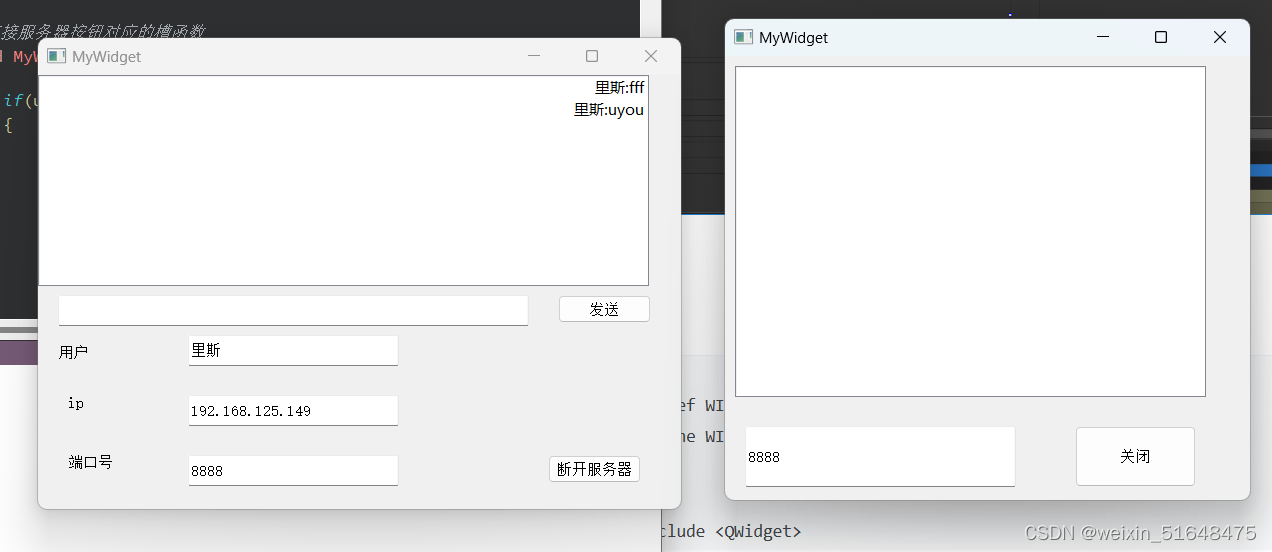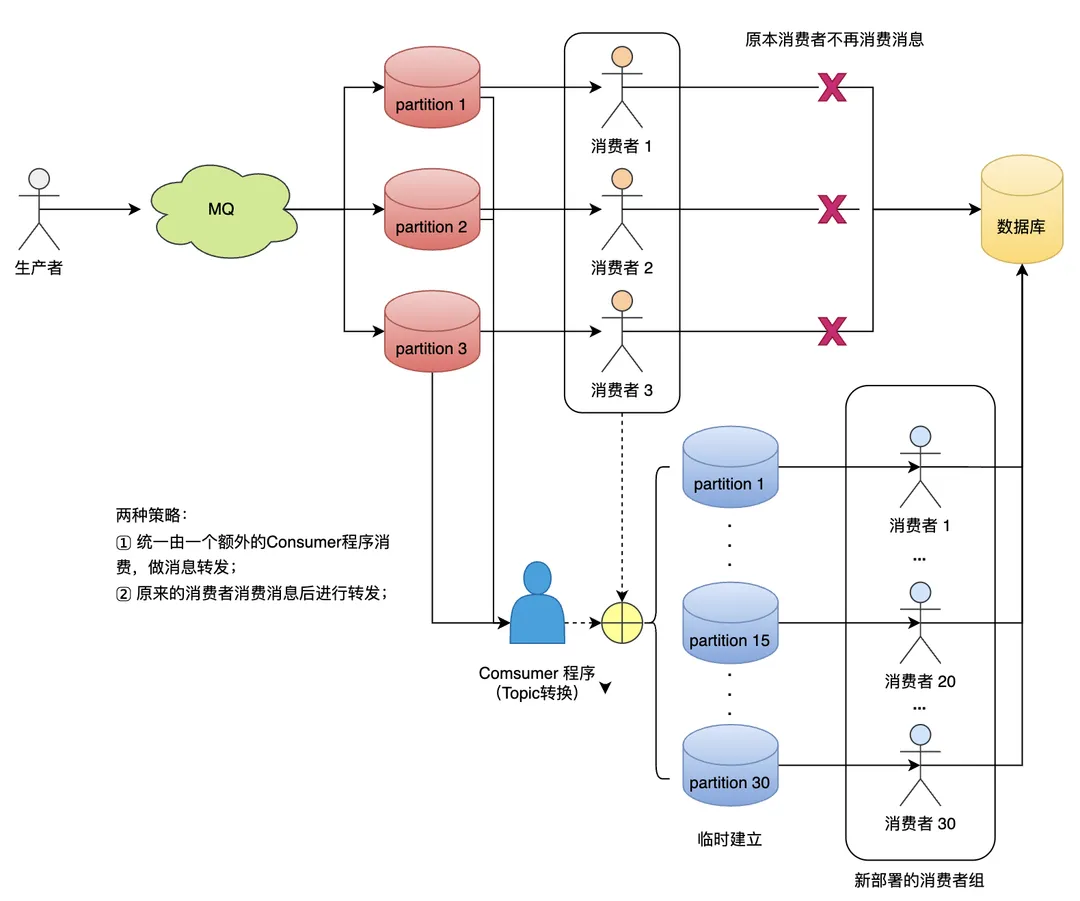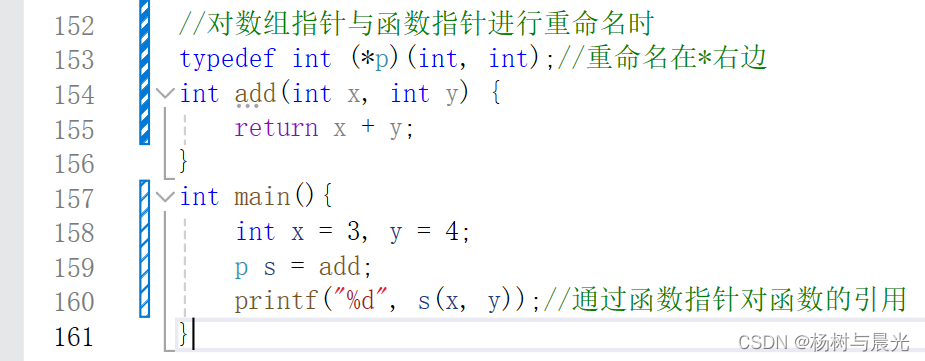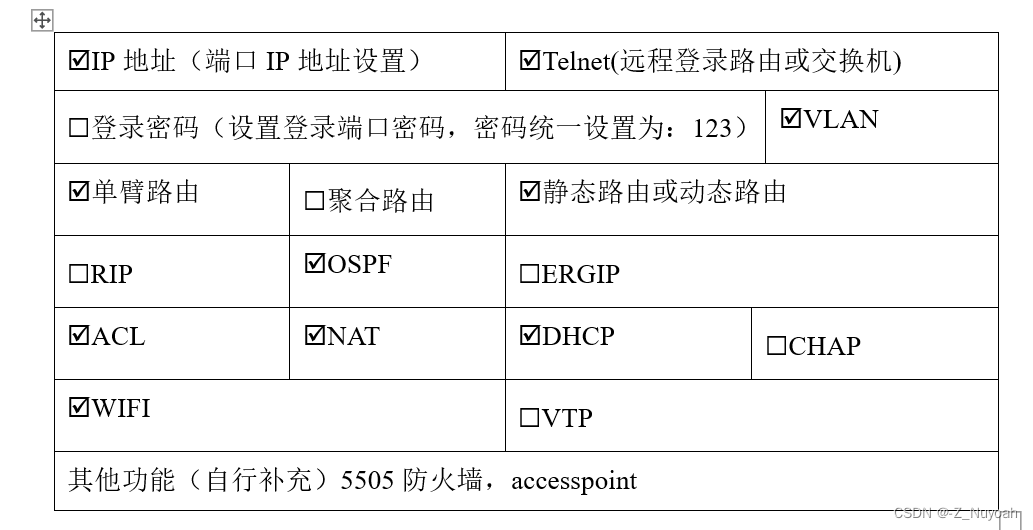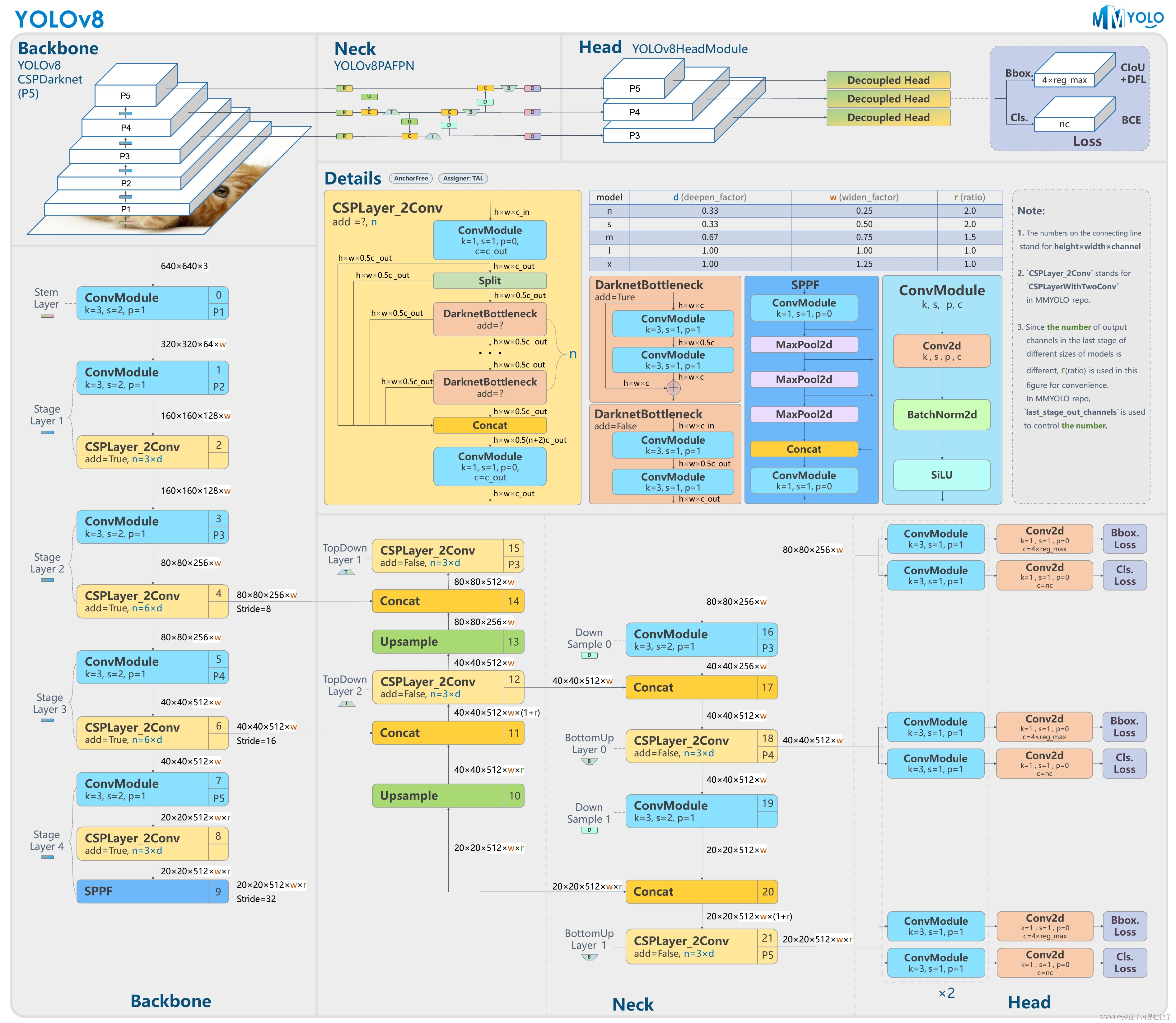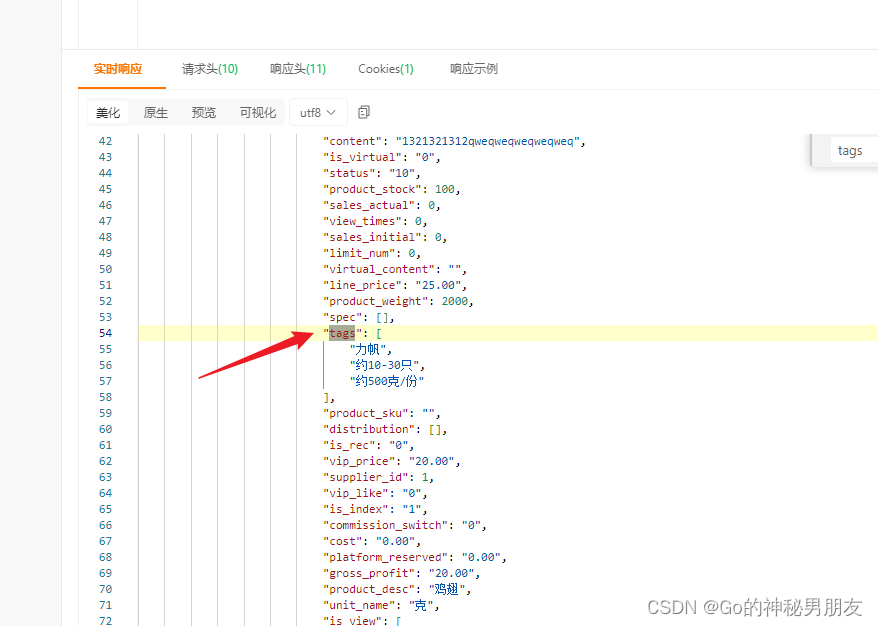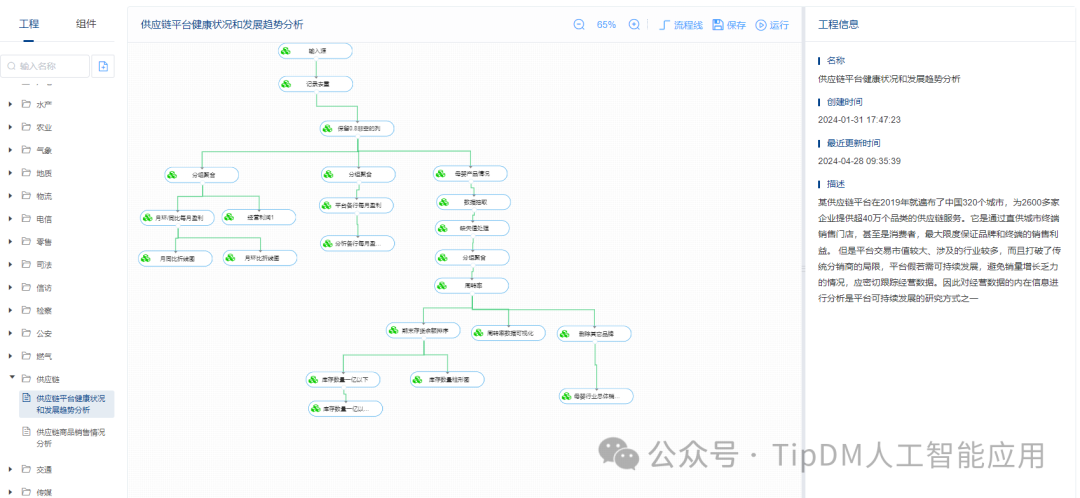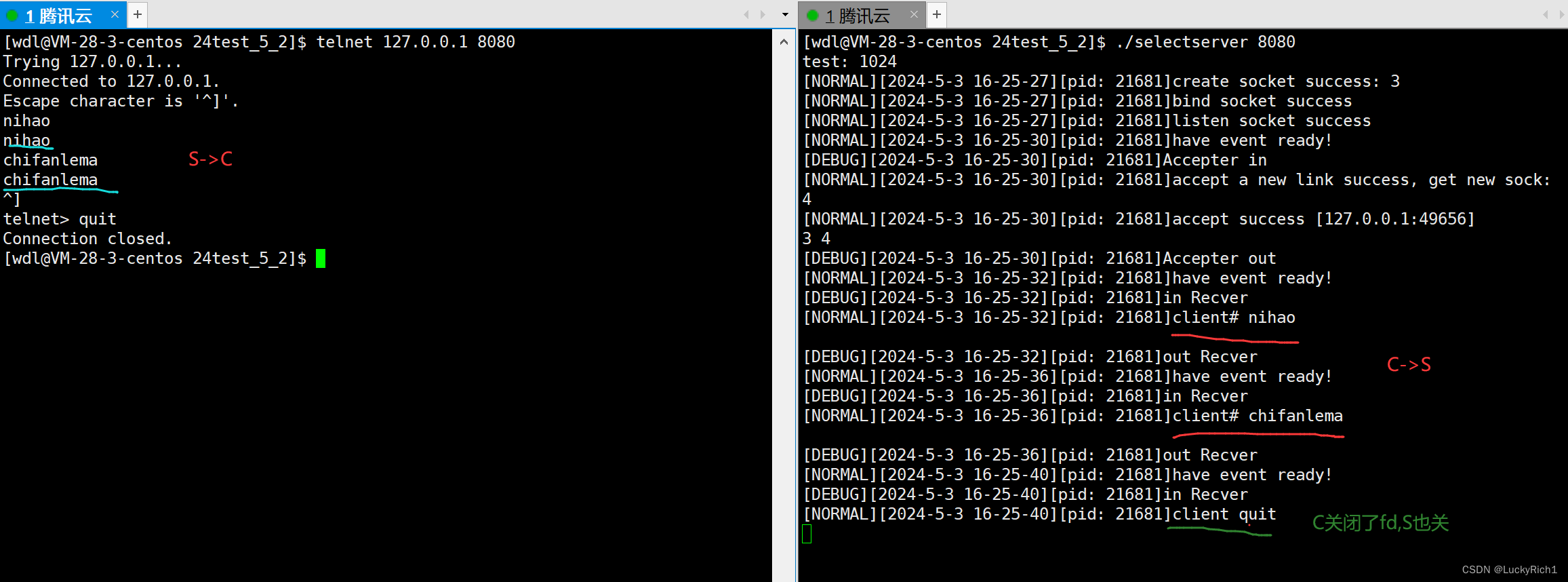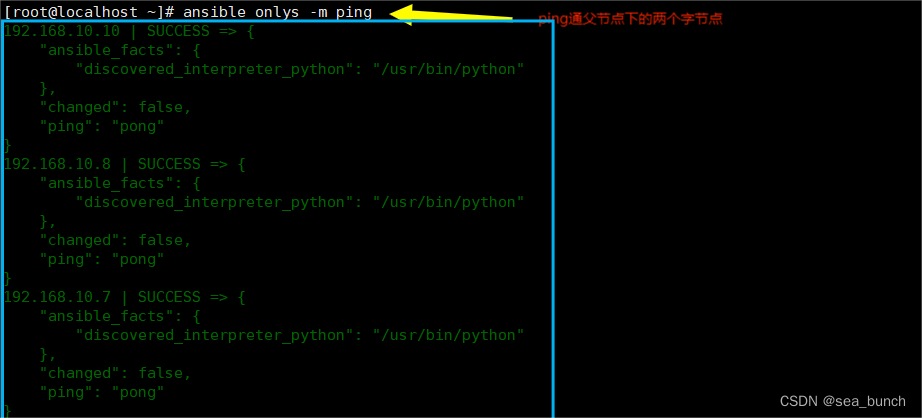Ardupilot Rpanion iperf网络性能测试
- 1. 源由
- 2. 分析
- 3. 安装
- 4. 测试
- 4.1 第一次测试
- 4.1.1 iperf测试参数A
- 4.1.1.1 测试链路1
- 4.1.1.2 测试链路2
- 4.1.1.3 测试链路3
- 4.1.2 iperf测试参数B - 测试链路3
- 4.1.2.1 测试数据
- 4.1.2.2 数据简单分析
- 4.1.2.3 数据深入分析
- 4.1.2.4 模拟测试网络
- 4.2 第二次测试
- 4.2.1 测试数据
- 4.2.2 数据分析
- 4.2.3 网络延迟分析
- 4.2.4 视频效果
- 4.3 第三次测试
- 4.3.1 测试数据
- 4.3.2 数据分析
- 4.3.3 网络延迟分析
- 4.3.4 视频效果
- 5. 总结
- 6. 参考资料
- 7. ZeroTier优化办法 - Moon节点
- 7.1 服务端配置
- 7.2 客户端配置
- 8. DJI RC系统性能
1. 源由
网络性能测试主要目的是:
-
评估网络健康状况:网络性能测试可以帮助评估网络的健康状况,包括带宽、延迟、丢包率等指标。通过了解网络的实际性能,可以及时发现并解决网络瓶颈和问题,确保网络的正常运行。
-
优化网络性能:通过网络性能测试,可以确定网络中存在的瓶颈和性能问题,并采取相应的优化措施。这包括调整网络设备配置、优化网络拓扑、升级网络硬件等,以提高网络的吞吐量、稳定性和可靠性。
-
规划网络扩展和升级:网络性能测试可以帮助企业规划网络的扩展和升级,以满足不断增长的业务需求。通过了解当前网络的性能状况和未来的需求,可以更好地规划网络架构、设备采购和部署策略。
-
保障用户体验:良好的网络性能是保障用户体验的关键。网络性能测试可以帮助确保网络对用户提供良好的服务质量,包括快速的响应时间、稳定的连接和高质量的数据传输。
-
提高网络安全:网络性能测试还可以帮助发现和解决网络安全漏洞和风险。通过测试网络的性能和安全性,可以识别潜在的安全威胁,并采取相应的防护措施,提高网络的安全性和可靠性。
最近要做的是针对视频、电传链路的评估,其在VPN/4G-LTE下性能到底如何?
- 《ArduPilot开源代码之CompanionComputer上天计划》
- 《Ardupilot开源代码之Rover上路计划》
2. 分析
在进行网络性能测试时,其主要步骤如下:
-
清晰的测试目标:确定您要测试的网络性能指标,例如带宽、延迟、丢包率等。确保您的测试目标清晰明确,并且测试过程中能够量化和记录这些指标。
-
选择适当的测试工具:根据您的测试需求选择合适的工具。一些常用的网络性能测试工具包括iperf、Wireshark、PingPlotter等。确保您选择的工具能够提供您需要的功能和数据输出。
-
测试环境的准备:在进行测试之前,确保测试环境的稳定性和一致性。避免在网络负载较高的时段进行测试,以免影响测试结果。另外,确保测试设备和网络连接的稳定性,以避免测试过程中出现干扰或故障。
-
数据采集和分析:在测试过程中,及时记录测试数据,并进行分析和比较。这些数据可以帮助您评估网络性能,并识别潜在的问题和瓶颈。确保您使用的工具能够提供详细的测试结果和分析功能。
-
安全性和合规性:在进行网络性能测试时,确保您的测试活动不会对网络安全造成威胁,并遵守相关的法律法规和政策要求。在测试之前,与相关部门或团队沟通,确保您的测试活动符合组织的安全和合规标准。
-
测试结果的验证和确认:在完成测试之后,验证和确认测试结果的准确性和可靠性。如果可能,进行多次测试以确保结果的一致性,并与预期的性能指标进行比较。
综上所述,网络性能测试需要仔细的规划和准备工作,以确保测试结果的准确性和可信度。通过遵循上述注意事项,您可以更好地评估和优化网络性能,提高网络的稳定性和效率。
3. 安装
- Jetson Orin Nano
$ sudo apt-get install iperf
$ iperf --version
iperf version 2.1.5 (3 December 2021) pthreads
- Raspberrry Pi 3B+
$ sudo apt-get install iperf
$ iperf --version
iperf version 2.0.14a (2 October 2020) pthreads
$ iperf --version
iperf version 2.1.5 (3 December 2021) pthreads
daniel@daniel-nvidia:~$ iperf -h
Usage: iperf [-s|-c host] [options]
iperf [-h|--help] [-v|--version]
Client/Server:
-b, --bandwidth #[kmgKMG | pps] bandwidth to read/send at in bits/sec or packets/sec
-e, --enhanced use enhanced reporting giving more tcp/udp and traffic information
-f, --format [kmgKMG] format to report: Kbits, Mbits, KBytes, MBytes
--hide-ips hide ip addresses and host names within outputs
-i, --interval # seconds between periodic bandwidth reports
-l, --len #[kmKM] length of buffer in bytes to read or write (Defaults: TCP=128K, v4 UDP=1470, v6 UDP=1450)
-m, --print_mss print TCP maximum segment size (MTU - TCP/IP header)
-o, --output <filename> output the report or error message to this specified file
-p, --port # client/server port to listen/send on and to connect
--permit-key permit key to be used to verify client and server (TCP only)
--sum-only output sum only reports
-u, --udp use UDP rather than TCP
-w, --window #[KM] TCP window size (socket buffer size)
-z, --realtime request realtime scheduler
-B, --bind <host>[:<port>][%<dev>] bind to <host>, ip addr (including multicast address) and optional port and device
-C, --compatibility for use with older versions does not sent extra msgs
-M, --mss # set TCP maximum segment size (MTU - 40 bytes)
-N, --nodelay set TCP no delay, disabling Nagle's Algorithm
-S, --tos # set the socket's IP_TOS (byte) field
-Z, --tcp-congestion <algo> set TCP congestion control algorithm (Linux only)
Server specific:
-p, --port #[-#] server port(s) to listen on/connect to
-s, --server run in server mode
-1, --singleclient run one server at a time
--histograms enable latency histograms
--permit-key-timeout set the timeout for a permit key in seconds
--tcp-rx-window-clamp set the TCP receive window clamp size in bytes
--tap-dev #[<dev>] use TAP device to receive at L2 layer
-t, --time # time in seconds to listen for new connections as well as to receive traffic (default not set)
--udp-histogram #,# enable UDP latency histogram(s) with bin width and count, e.g. 1,1000=1(ms),1000(bins)
-B, --bind <ip>[%<dev>] bind to multicast address and optional device
-U, --single_udp run in single threaded UDP mode
--sum-dstip sum traffic threads based upon destination ip address (default is src ip)
-D, --daemon run the server as a daemon
-V, --ipv6_domain Enable IPv6 reception by setting the domain and socket to AF_INET6 (Can receive on both IPv4 and IPv6)
Client specific:
-c, --client <host> run in client mode, connecting to <host>
--connect-only run a connect only test
--connect-retries # number of times to retry tcp connect
-d, --dualtest Do a bidirectional test simultaneously (multiple sockets)
--fq-rate #[kmgKMG] bandwidth to socket pacing
--full-duplex run full duplex test using same socket
--ipg set the the interpacket gap (milliseconds) for packets within an isochronous frame
--isochronous <frames-per-second>:<mean>,<stddev> send traffic in bursts (frames - emulate video traffic)
--incr-dstip Increment the destination ip with parallel (-P) traffic threads
--incr-dstport Increment the destination port with parallel (-P) traffic threads
--incr-srcip Increment the source ip with parallel (-P) traffic threads
--incr-srcport Increment the source port with parallel (-P) traffic threads
--local-only Set don't route on socket
--near-congestion=[w] Use a weighted write delay per the sampled TCP RTT (experimental)
--no-connect-sync No sychronization after connect when -P or parallel traffic threads
--no-udp-fin No final server to client stats at end of UDP test
-n, --num #[kmgKMG] number of bytes to transmit (instead of -t)
-r, --tradeoff Do a fullduplexectional test individually
--tcp-write-prefetch set the socket's TCP_NOTSENT_LOWAT value in bytes and use event based writes
-t, --time # time in seconds to transmit for (default 10 secs)
--trip-times enable end to end measurements (requires client and server clock sync)
--txdelay-time time in seconds to hold back after connect and before first write
--txstart-time unix epoch time to schedule first write and start traffic
-B, --bind [<ip> | <ip:port>] bind ip (and optional port) from which to source traffic
-F, --fileinput <name> input the data to be transmitted from a file
-H, --ssm-host <ip> set the SSM source, use with -B for (S,G)
-I, --stdin input the data to be transmitted from stdin
-L, --listenport # port to receive fullduplexectional tests back on
-P, --parallel # number of parallel client threads to run
-R, --reverse reverse the test (client receives, server sends)
-S, --tos IP DSCP or tos settings
-T, --ttl # time-to-live, for multicast (default 1)
-V, --ipv6_domain Set the domain to IPv6 (send packets over IPv6)
-X, --peer-detect perform server version detection and version exchange
Miscellaneous:
-x, --reportexclude [CDMSV] exclude C(connection) D(data) M(multicast) S(settings) V(server) reports
-y, --reportstyle C report as a Comma-Separated Values
-h, --help print this message and quit
-v, --version print version information and quit
[kmgKMG] Indicates options that support a k,m,g,K,M or G suffix
Lowercase format characters are 10^3 based and uppercase are 2^n based
(e.g. 1k = 1000, 1K = 1024, 1m = 1,000,000 and 1M = 1,048,576)
The TCP window size option can be set by the environment variable
TCP_WINDOW_SIZE. Most other options can be set by an environment variable
IPERF_<long option name>, such as IPERF_BANDWIDTH.
Source at <http://sourceforge.net/projects/iperf2/>
Report bugs to <iperf-users@lists.sourceforge.net>
4. 测试
- 测试指标:带宽、延迟、丢包率、稳定性。其他的可靠性、安全性等暂不考虑。
- 测试工具:iperf
4.1 第一次测试
目前,本地已有的测试环境的【网络拓扑A】,如下所示:
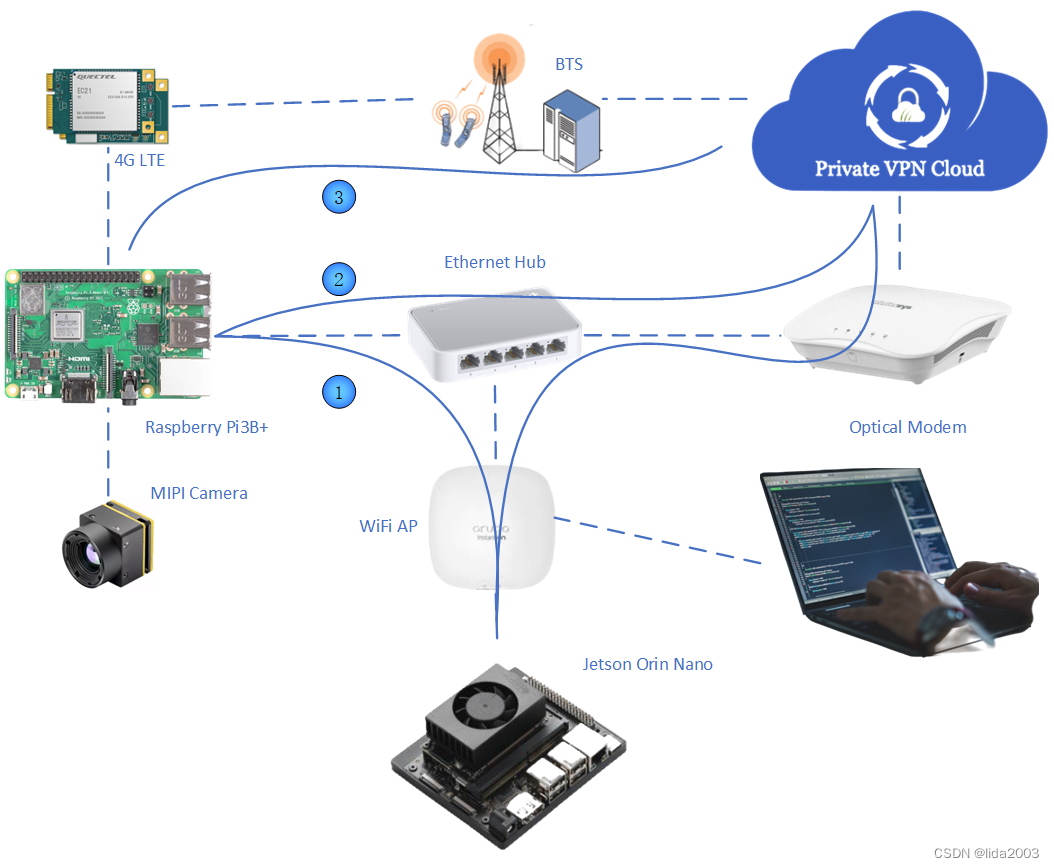
4.1.1 iperf测试参数A
- 服务端:
iperf -u -s - 客户端:
iperf -u -T 10 -b [1M] -c [server address]
4.1.1.1 测试链路1
- 局域网测试:Pi --> Hub --> Jetson
- 服务端IP地址:192.168.1.19 (Jetson)
- 客户端IP地址:192.168.1.201 (Pi)
$ iperf -u -T 10 -b 1M -c 192.168.1.19
------------------------------------------------------------
Client connecting to 192.168.1.19, UDP port 5001
UDP buffer size: 208 KByte (default)
------------------------------------------------------------
[ 3] local 192.168.1.201 port 49022 connected with 192.168.1.19 port 5001
[ ID] Interval Transfer Bandwidth
[ 3] 0.0000-10.0153 sec 1.25 MBytes 1.05 Mbits/sec
[ 3] Sent 896 datagrams
[ 3] Server Report:
[ ID] Interval Transfer Bandwidth Jitter Lost/Total Datagrams
[ 3] 0.0000-10.0116 sec 1.25 MBytes 1.05 Mbits/sec 3.065 ms 0/ 895 (0%)
$ iperf -u -T 10 -b 2M -c 192.168.1.19
------------------------------------------------------------
Client connecting to 192.168.1.19, UDP port 5001
UDP buffer size: 208 KByte (default)
------------------------------------------------------------
[ 3] local 192.168.1.201 port 46959 connected with 192.168.1.19 port 5001
[ ID] Interval Transfer Bandwidth
[ 3] 0.0000-10.0098 sec 2.50 MBytes 2.10 Mbits/sec
[ 3] Sent 1788 datagrams
[ 3] Server Report:
[ ID] Interval Transfer Bandwidth Jitter Lost/Total Datagrams
[ 3] 0.0000-9.9998 sec 2.50 MBytes 2.10 Mbits/sec 2.513 ms 0/ 1787 (0%)
$ iperf -u -T 10 -b 3M -c 192.168.1.19
------------------------------------------------------------
Client connecting to 192.168.1.19, UDP port 5001
UDP buffer size: 208 KByte (default)
------------------------------------------------------------
[ 3] local 192.168.1.201 port 44713 connected with 192.168.1.19 port 5001
[ ID] Interval Transfer Bandwidth
[ 3] 0.0000-10.0079 sec 3.75 MBytes 3.15 Mbits/sec
[ 3] Sent 2680 datagrams
[ 3] Server Report:
[ ID] Interval Transfer Bandwidth Jitter Lost/Total Datagrams
[ 3] 0.0000-10.0206 sec 3.75 MBytes 3.14 Mbits/sec 2.352 ms 1/ 2679 (0.037%)
-
1M带宽测试:
带宽:1.05 Mbits/sec
丢包率:0%
Jitter:3.065 ms -
2M带宽测试:
带宽:2.10 Mbits/sec
丢包率:0%
Jitter:2.513 ms -
3M带宽测试:
带宽:3.14 Mbits/sec
丢包率:0.037%
Jitter:2.352 ms
4.1.1.2 测试链路2
- 预设条件:4G LTE SIM卡移除
- VPN测试:Pi --> Hub --> Modem --> Server --> Modem --> Hub --> AP --> Jetson
- 服务端IP地址:172.24.42.46 (Jetson)
- 客户端IP地址:172.24.161.33 (Pi)
$ iperf -u -T 10 -b 1M -c 172.24.42.46
------------------------------------------------------------
Client connecting to 172.24.42.46, UDP port 5001
UDP buffer size: 208 KByte (default)
------------------------------------------------------------
[ 3] local 172.24.161.33 port 43642 connected with 172.24.42.46 port 5001
[ ID] Interval Transfer Bandwidth
[ 3] 0.0000-10.0153 sec 1.25 MBytes 1.05 Mbits/sec
[ 3] Sent 896 datagrams
[ 3] Server Report:
[ ID] Interval Transfer Bandwidth Jitter Lost/Total Datagrams
[ 3] 0.0000-9.9983 sec 1.25 MBytes 1.05 Mbits/sec 3.425 ms 0/ 895 (0%)
$ iperf -u -T 10 -b 2M -c 172.24.42.46
------------------------------------------------------------
Client connecting to 172.24.42.46, UDP port 5001
UDP buffer size: 208 KByte (default)
------------------------------------------------------------
[ 3] local 172.24.161.33 port 43610 connected with 172.24.42.46 port 5001
[ ID] Interval Transfer Bandwidth
[ 3] 0.0000-10.0098 sec 2.50 MBytes 2.10 Mbits/sec
[ 3] Sent 1788 datagrams
[ 3] Server Report:
[ ID] Interval Transfer Bandwidth Jitter Lost/Total Datagrams
[ 3] 0.0000-10.0097 sec 2.50 MBytes 2.10 Mbits/sec 3.465 ms 0/ 1787 (0%)
$ iperf -u -T 10 -b 3M -c 172.24.42.46
------------------------------------------------------------
Client connecting to 172.24.42.46, UDP port 5001
UDP buffer size: 208 KByte (default)
------------------------------------------------------------
[ 3] local 172.24.161.33 port 37048 connected with 172.24.42.46 port 5001
[ ID] Interval Transfer Bandwidth
[ 3] 0.0000-10.0041 sec 3.75 MBytes 3.15 Mbits/sec
[ 3] Sent 2679 datagrams
[ 3] Server Report:
[ ID] Interval Transfer Bandwidth Jitter Lost/Total Datagrams
[ 3] 0.0000-10.0336 sec 3.75 MBytes 3.14 Mbits/sec 4.807 ms 0/ 2678 (0%)
-
1M带宽测试:
带宽:1.05 Mbits/sec
丢包率:0%
Jitter:3.425 ms -
2M带宽测试:
带宽:2.10 Mbits/sec
丢包率:0%
Jitter:3.465 ms -
3M带宽测试:
带宽:3.14 Mbits/sec
丢包率:0%
Jitter:4.807 ms
4.1.1.3 测试链路3
- 预设条件:有线IP网络物理断开
- VPN测试:Pi --> 4G LTE --> BTS --> Server --> Modem --> Hub --> AP --> Jetson
- 服务端IP地址:172.24.42.46 (Jetson)
- 客户端IP地址:172.24.161.33 (Pi)
$ iperf -u -T 10 -b 1M -c 172.24.42.46
------------------------------------------------------------
Client connecting to 172.24.42.46, UDP port 5001
UDP buffer size: 208 KByte (default)
------------------------------------------------------------
[ 3] local 172.24.161.33 port 34869 connected with 172.24.42.46 port 5001
[ ID] Interval Transfer Bandwidth
[ 3] 0.0000-10.0154 sec 1.25 MBytes 1.05 Mbits/sec
[ 3] Sent 896 datagrams
[ 3] Server Report:
[ ID] Interval Transfer Bandwidth Jitter Lost/Total Datagrams
[ 3] 0.0000-9.9907 sec 1.25 MBytes 1.05 Mbits/sec 8.210 ms 0/ 895 (0%)
$ iperf -u -T 10 -b 2M -c 172.24.42.46
------------------------------------------------------------
Client connecting to 172.24.42.46, UDP port 5001
UDP buffer size: 208 KByte (default)
------------------------------------------------------------
[ 3] local 172.24.161.33 port 35665 connected with 172.24.42.46 port 5001
[ ID] Interval Transfer Bandwidth
[ 3] 0.0000-10.0098 sec 2.50 MBytes 2.10 Mbits/sec
[ 3] Sent 1788 datagrams
[ 3] Server Report:
[ ID] Interval Transfer Bandwidth Jitter Lost/Total Datagrams
[ 3] 0.0000-9.9933 sec 2.50 MBytes 2.10 Mbits/sec 7.350 ms 0/ 1787 (0%)
$ iperf -u -T 10 -b 3M -c 172.24.42.46
------------------------------------------------------------
Client connecting to 172.24.42.46, UDP port 5001
UDP buffer size: 208 KByte (default)
------------------------------------------------------------
[ 3] local 172.24.161.33 port 43883 connected with 172.24.42.46 port 5001
[ ID] Interval Transfer Bandwidth
[ 3] 0.0000-10.0079 sec 3.75 MBytes 3.15 Mbits/sec
[ 3] Sent 2680 datagrams
[ 3] Server Report:
[ ID] Interval Transfer Bandwidth Jitter Lost/Total Datagrams
[ 3] 0.0000-10.0150 sec 3.75 MBytes 3.14 Mbits/sec 5.268 ms 0/ 2679 (0%)
-
1M带宽测试:
带宽:1.05 Mbits/sec
丢包率:0%
Jitter:8.210 ms -
2M带宽测试:
带宽:2.10 Mbits/sec
丢包率:0%
Jitter:7.350 ms -
3M带宽测试:
带宽:3.14 Mbits/sec
丢包率:0%
Jitter:5.268 ms
4.1.2 iperf测试参数B - 测试链路3
为什么要引入测试参数B?主要原因是:
- 4G LTE视频发现花屏+卡顿现象
- 测试参数A给出的1/2/3链路状况都是非常理想的
上述两个现象与实际结果发生了严重的不一致问题,太困惑了。
- 4G LTE networks results in significant screen freezing and stuttering #225
怀疑:是否是iperf测试参数问题导致测试结果不准确。因此,调整测试参数如下:
- 服务端:
iperf -u -s - 客户端:
iperf -u -T 10 -b [1M] -l 20 -e -i 1 -t 60 -c [server address]
预设条件:有线IP网络物理断开
VPN测试:Pi --> 4G LTE --> BTS --> Server --> Modem --> Hub --> AP --> Jetson
服务端IP地址:172.24.42.46 (Jetson)
客户端IP地址:172.24.161.33 (Pi)
4.1.2.1 测试数据
$ iperf -u -T 10 -b 2M -l 20 -e -i 1 -t 60 -c 172.24.42.46
------------------------------------------------------------
Client connecting to 172.24.42.46, UDP port 5001 with pid 950 (1 flows)
Write buffer size: 20.0 Byte
UDP buffer size: 208 KByte (default)
------------------------------------------------------------
[ 3] local 172.24.161.33%zt44xhvvrc port 57316 connected with 172.24.42.46 port 5001
[ ID] Interval Transfer Bandwidth Write/Err PPS
[ 3] 0.0000-1.0000 sec 256 KBytes 2.10 Mbits/sec 13104/0 13105 pps
[ 3] 1.0000-2.0000 sec 256 KBytes 2.10 Mbits/sec 13111/0 13112 pps
[ 3] 2.0000-3.0000 sec 256 KBytes 2.10 Mbits/sec 13108/0 13106 pps
[ 3] 3.0000-4.0000 sec 256 KBytes 2.10 Mbits/sec 13106/0 13108 pps
[ 3] 4.0000-5.0000 sec 256 KBytes 2.10 Mbits/sec 13107/0 13108 pps
[ 3] 5.0000-6.0000 sec 256 KBytes 2.10 Mbits/sec 13107/0 13105 pps
[ 3] 6.0000-7.0000 sec 256 KBytes 2.10 Mbits/sec 13107/0 13107 pps
[ 3] 7.0000-8.0000 sec 256 KBytes 2.10 Mbits/sec 13109/0 13108 pps
[ 3] 8.0000-9.0000 sec 256 KBytes 2.10 Mbits/sec 13103/0 13103 pps
[ 3] 9.0000-10.0000 sec 256 KBytes 2.10 Mbits/sec 13108/0 13112 pps
[ 3] 10.0000-11.0000 sec 256 KBytes 2.10 Mbits/sec 13111/0 13106 pps
[ 3] 11.0000-12.0000 sec 256 KBytes 2.10 Mbits/sec 13106/0 13108 pps
[ 3] 12.0000-13.0000 sec 256 KBytes 2.10 Mbits/sec 13108/0 13107 pps
[ 3] 13.0000-14.0000 sec 256 KBytes 2.10 Mbits/sec 13105/0 13107 pps
[ 3] 14.0000-15.0000 sec 256 KBytes 2.10 Mbits/sec 13105/0 13102 pps
[ 3] 15.0000-16.0000 sec 256 KBytes 2.10 Mbits/sec 13112/0 13113 pps
[ 3] 16.0000-17.0000 sec 256 KBytes 2.10 Mbits/sec 13104/0 13104 pps
[ 3] 17.0000-18.0000 sec 256 KBytes 2.10 Mbits/sec 13109/0 13111 pps
[ 3] 18.0000-19.0000 sec 256 KBytes 2.10 Mbits/sec 13109/0 13107 pps
[ 3] 19.0000-20.0000 sec 256 KBytes 2.10 Mbits/sec 13105/0 13107 pps
[ 3] 20.0000-21.0000 sec 256 KBytes 2.10 Mbits/sec 13108/0 13105 pps
[ 3] 21.0000-22.0000 sec 256 KBytes 2.10 Mbits/sec 13105/0 13109 pps
[ 3] 22.0000-23.0000 sec 256 KBytes 2.10 Mbits/sec 13097/0 13107 pps
[ 3] 23.0000-24.0000 sec 256 KBytes 2.10 Mbits/sec 13120/0 13107 pps
[ 3] 24.0000-25.0000 sec 256 KBytes 2.10 Mbits/sec 13106/0 13105 pps
[ 3] 25.0000-26.0000 sec 256 KBytes 2.10 Mbits/sec 13107/0 13110 pps
[ 3] 26.0000-27.0000 sec 256 KBytes 2.10 Mbits/sec 13107/0 13105 pps
[ 3] 27.0000-28.0000 sec 256 KBytes 2.10 Mbits/sec 13107/0 13109 pps
[ 3] 28.0000-29.0000 sec 256 KBytes 2.10 Mbits/sec 13108/0 13105 pps
[ 3] 29.0000-30.0000 sec 256 KBytes 2.10 Mbits/sec 13107/0 13107 pps
[ 3] 30.0000-31.0000 sec 256 KBytes 2.10 Mbits/sec 13106/0 13106 pps
[ 3] 31.0000-32.0000 sec 256 KBytes 2.10 Mbits/sec 13109/0 13110 pps
[ 3] 32.0000-33.0000 sec 256 KBytes 2.10 Mbits/sec 13108/0 13108 pps
[ 3] 33.0000-34.0000 sec 256 KBytes 2.10 Mbits/sec 13104/0 13107 pps
[ 3] 34.0000-35.0000 sec 256 KBytes 2.10 Mbits/sec 13109/0 13105 pps
[ 3] 35.0000-36.0000 sec 256 KBytes 2.10 Mbits/sec 13109/0 13109 pps
[ 3] 36.0000-37.0000 sec 256 KBytes 2.10 Mbits/sec 13106/0 13108 pps
[ 3] 37.0000-38.0000 sec 256 KBytes 2.10 Mbits/sec 13107/0 13105 pps
[ 3] 38.0000-39.0000 sec 256 KBytes 2.10 Mbits/sec 13108/0 13109 pps
[ 3] 39.0000-40.0000 sec 256 KBytes 2.10 Mbits/sec 13106/0 13107 pps
[ 3] 40.0000-41.0000 sec 256 KBytes 2.10 Mbits/sec 13107/0 13107 pps
[ 3] 41.0000-42.0000 sec 256 KBytes 2.10 Mbits/sec 13109/0 13107 pps
[ 3] 42.0000-43.0000 sec 256 KBytes 2.10 Mbits/sec 13105/0 13107 pps
[ 3] 43.0000-44.0000 sec 256 KBytes 2.10 Mbits/sec 13108/0 13107 pps
[ 3] 44.0000-45.0000 sec 256 KBytes 2.10 Mbits/sec 13107/0 13107 pps
[ 3] 45.0000-46.0000 sec 256 KBytes 2.10 Mbits/sec 13107/0 13104 pps
[ 3] 46.0000-47.0000 sec 256 KBytes 2.10 Mbits/sec 13109/0 13109 pps
[ 3] 47.0000-48.0000 sec 256 KBytes 2.10 Mbits/sec 13107/0 13108 pps
[ 3] 48.0000-49.0000 sec 256 KBytes 2.10 Mbits/sec 13107/0 13106 pps
[ 3] 49.0000-50.0000 sec 256 KBytes 2.10 Mbits/sec 13105/0 13105 pps
[ 3] 50.0000-51.0000 sec 256 KBytes 2.10 Mbits/sec 13110/0 13110 pps
[ 3] 51.0000-52.0000 sec 256 KBytes 2.10 Mbits/sec 13104/0 13108 pps
[ 3] 52.0000-53.0000 sec 256 KBytes 2.10 Mbits/sec 13110/0 13106 pps
[ 3] 53.0000-54.0000 sec 256 KBytes 2.10 Mbits/sec 13108/0 13108 pps
[ 3] 54.0000-55.0000 sec 256 KBytes 2.10 Mbits/sec 13105/0 13108 pps
[ 3] 55.0000-56.0000 sec 256 KBytes 2.10 Mbits/sec 13108/0 13107 pps
[ 3] 56.0000-57.0000 sec 256 KBytes 2.10 Mbits/sec 13108/0 13107 pps
[ 3] 57.0000-58.0000 sec 256 KBytes 2.10 Mbits/sec 13107/0 13106 pps
[ 3] 58.0000-59.0000 sec 256 KBytes 2.10 Mbits/sec 13106/0 13106 pps
[ 3] 59.0000-60.0000 sec 256 KBytes 2.10 Mbits/sec 13107/0 13108 pps
[ 3] 0.0000-60.0007 sec 15.0 MBytes 2.10 Mbits/sec 786443/0 13107 pps
[ 3] Sent 786443 datagrams
[ 3] Server Report:
[ ID] Interval Transfer Bandwidth Jitter Lost/Total Datagrams
[ 3] 0.0000-60.1233 sec 7.88 MBytes 1.10 Mbits/sec 0.145 ms 373400/786443 (47%)
[ 3] 0.0000-60.1233 sec 32 datagrams received out-of-order
4.1.2.2 数据简单分析
- 测试设置为使用UDP协议,目标带宽为2Mbps,发送数据包大小为20字节,持续时间为60秒。
- 客户端连接到IP地址为172.24.42.46的服务器。
- 在整个测试期间,每秒发送的数据包数量保持在大约13100个左右,除非有数据包丢失,否则保持稳定。
- 服务器报告显示,在60秒的测试期间,共发送了786443个数据包,其中约47%的数据包丢失,且有32个数据包接收时顺序错乱。
- 带宽的实际测量结果约为1.10 Mbits/sec,明显低于设定的2Mbps目标带宽。
综上所述,这些数据表明在给定的网络环境下存在丢包和顺序错乱的问题,导致带宽表现不佳。可能的原因包括网络拥塞、传输延迟、或网络设备配置问题。为解决这些问题,可以考虑优化网络配置、增加带宽、或改善网络连接质量。
4.1.2.3 数据深入分析
本次测试已经发现一些线索,至少确实可能存在链路状况不佳的情况。
分析对比测试线A v/s B的差异:
- 测试参数A:默认v4 UDP=1470, v6 UDP=1450
- 测试参数B:数据包大小20字节,每秒报文数量13105
在维持带宽情况下,小包数量增加,会引起网络拥塞,进而导致丢包率明显增加。此时,出现花屏和卡顿就不足为奇。
从这里可以认识到,之前的测试过于简单。
因为视频流并非只是发送一种长度的报文,可能是变化的;另外,在编码完成后,会有发送报文需求;在图像编码时,视频数据尚没有准备好,此时,并无数据发送需求,网络带宽是空闲的。
引入以下思考:视频传输H264编码P/I帧的数据发送是如何分布的(时空概念)?
- 报文大小分布情况如何?
- 报文发送速率如何?
- Bit Rate Throttling Algorithm on Video over RTP
举了一个例子:
- 高峰时刻I帧,5ms 15个数据包,而I帧又是完整的帧图像,如果此时出现丢包,那可不就是花屏、卡顿。
- 每间隔2秒,传输报文数量出现一个2倍峰值
- 15FPS(66.7ms)下,H264每隔62ms出现一个峰值大包传输集中点(时刻)

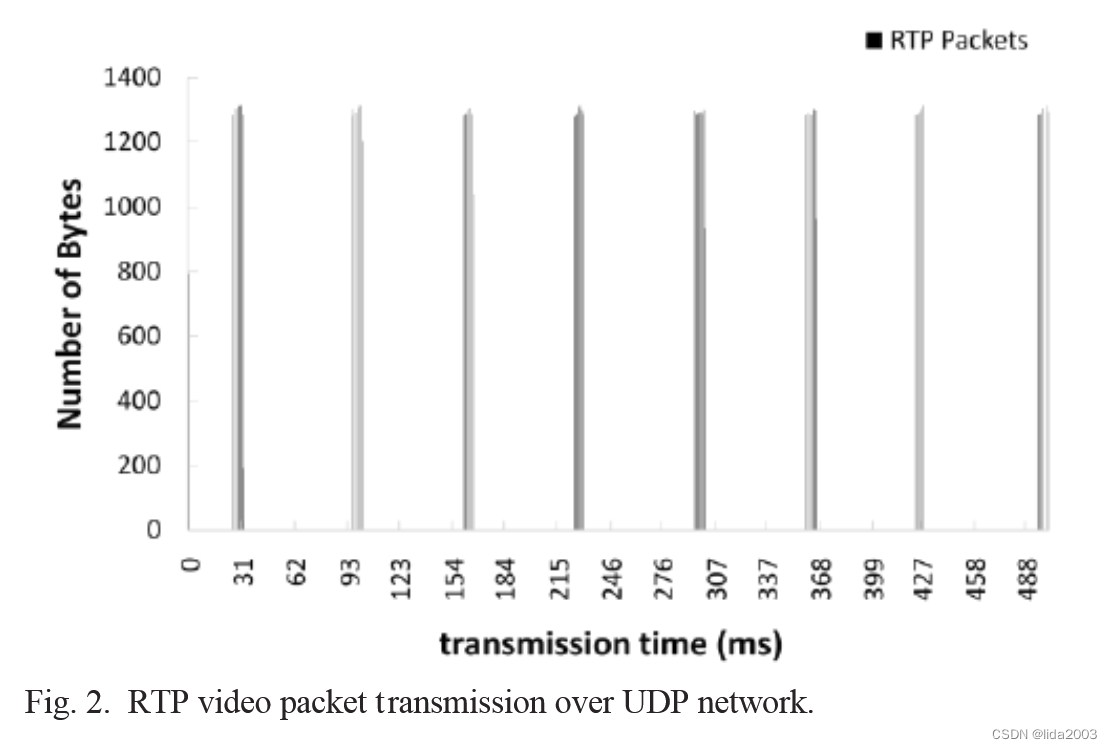
4.1.2.4 模拟测试网络
模拟高峰时刻带宽测试:5ms 15包数据(每秒15x1000/5=3000pps),1400字节一包。
- 实际测试网络,还存在其他视频链路,应用程序等等网络开销
- 模拟始终高压传输,导致带宽更加紧张,容易导致UDP丢包
最终结果:81%丢包率,压根没法看视频了(妥妥的2-8定律)
$ iperf -b 3000pps -u -e -i 1 -l 1400 -c 172.24.42.46
------------------------------------------------------------
Client connecting to 172.24.42.46, UDP port 5001 with pid 1137 (1 flows)
Write buffer size: 1.37 KByte
UDP buffer size: 208 KByte (default)
------------------------------------------------------------
[ 3] local 172.24.161.33%zt44xhvvrc port 49273 connected with 172.24.42.46 port 5001
[ ID] Interval Transfer Bandwidth Write/Err PPS
[ 3] 0.0000-1.0000 sec 4.01 MBytes 33.6 Mbits/sec 3001/0 3002 pps
[ 3] 1.0000-2.0000 sec 4.01 MBytes 33.6 Mbits/sec 3001/0 3000 pps
[ 3] 2.0000-3.0000 sec 4.00 MBytes 33.6 Mbits/sec 2996/0 3000 pps
[ 3] 3.0000-4.0000 sec 4.01 MBytes 33.6 Mbits/sec 3003/0 2999 pps
[ 3] 4.0000-5.0000 sec 4.01 MBytes 33.6 Mbits/sec 3000/0 3001 pps
[ 3] 5.0000-6.0000 sec 4.01 MBytes 33.6 Mbits/sec 3001/0 3000 pps
[ 3] 6.0000-7.0000 sec 4.00 MBytes 33.6 Mbits/sec 2999/0 3000 pps
[ 3] 7.0000-8.0000 sec 4.01 MBytes 33.6 Mbits/sec 3000/0 3000 pps
[ 3] 8.0000-9.0000 sec 4.01 MBytes 33.6 Mbits/sec 3000/0 3000 pps
[ 3] 9.0000-10.0000 sec 4.01 MBytes 33.6 Mbits/sec 3000/0 3000 pps
[ 3] 0.0000-10.0009 sec 40.1 MBytes 33.6 Mbits/sec 30005/0 3000 pps
[ 3] Sent 30005 datagrams
[ 3] Server Report:
[ ID] Interval Transfer Bandwidth Jitter Lost/Total Datagrams
[ 3] 0.0000-10.3893 sec 7.64 MBytes 6.17 Mbits/sec 2.070 ms 24283/30007 (81%)
4.2 第二次测试
鉴于第一次测试的网络拓扑问题,现在只用一个4G LTE链路:因此链路独享,功能单一,不会有太多的竞争关系。【网络拓扑B】调整如下:
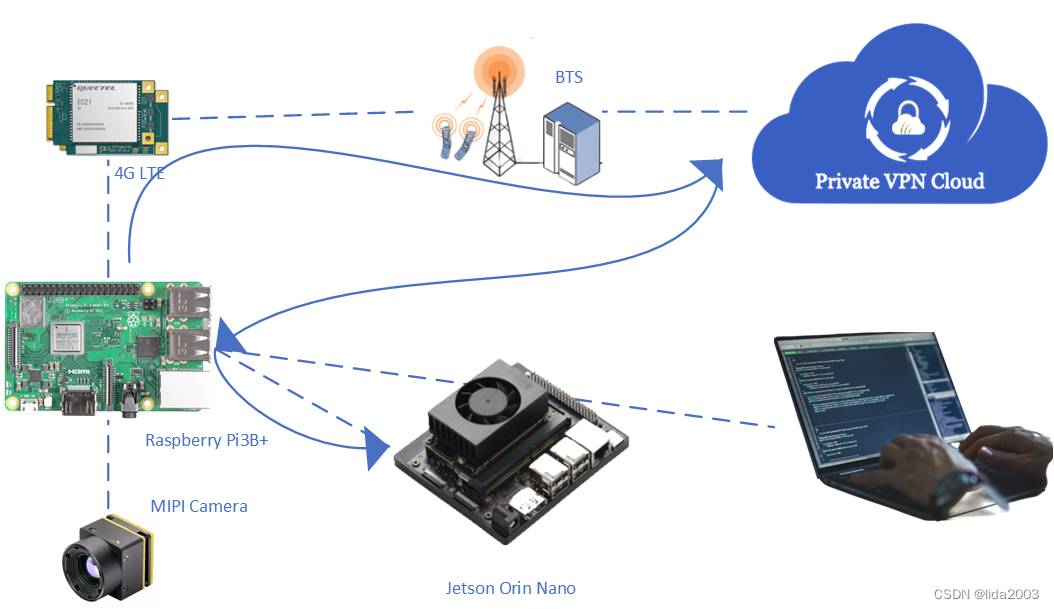
4.2.1 测试数据
$ iperf -b 3000pps -u -e -i 1 -l 1400 -c 172.24.42.46
------------------------------------------------------------
Client connecting to 172.24.42.46, UDP port 5001 with pid 1426 (1 flows)
Write buffer size: 1.37 KByte
UDP buffer size: 208 KByte (default)
------------------------------------------------------------
[ 3] local 172.24.161.33%zt44xhvvrc port 51044 connected with 172.24.42.46 port 5001
[ ID] Interval Transfer Bandwidth Write/Err PPS
[ 3] 0.0000-1.0000 sec 4.01 MBytes 33.6 Mbits/sec 3001/0 3002 pps
[ 3] 1.0000-2.0000 sec 4.01 MBytes 33.6 Mbits/sec 3000/0 3000 pps
[ 3] 2.0000-3.0000 sec 4.01 MBytes 33.6 Mbits/sec 3000/0 3000 pps
[ 3] 3.0000-4.0000 sec 4.01 MBytes 33.6 Mbits/sec 3001/0 3001 pps
[ 3] 4.0000-5.0000 sec 4.00 MBytes 33.6 Mbits/sec 2999/0 2999 pps
[ 3] 5.0000-6.0000 sec 4.01 MBytes 33.6 Mbits/sec 3000/0 3000 pps
[ 3] 6.0000-7.0000 sec 4.01 MBytes 33.6 Mbits/sec 3000/0 3000 pps
[ 3] 7.0000-8.0000 sec 4.01 MBytes 33.6 Mbits/sec 3000/0 3000 pps
[ 3] 8.0000-9.0000 sec 4.01 MBytes 33.6 Mbits/sec 3000/0 3000 pps
[ 3] 9.0000-10.0000 sec 4.01 MBytes 33.6 Mbits/sec 3000/0 3000 pps
[ 3] 0.0000-10.0009 sec 40.1 MBytes 33.6 Mbits/sec 30005/0 3000 pps
[ 3] Sent 30005 datagrams
[ 3] Server Report:
[ ID] Interval Transfer Bandwidth Jitter Lost/Total Datagrams
[ 3] 0.0000-10.2656 sec 37.5 MBytes 30.7 Mbits/sec 0.268 ms 1890/30004 (6.3%)
注:更多测试数据供参考。
daniel@rpanion:~ $ iperf -b 3000pps -u -e -i 1 -l 1400 -c 172.24.42.46
------------------------------------------------------------
Client connecting to 172.24.42.46, UDP port 5001 with pid 1510 (1 flows)
Write buffer size: 1.37 KByte
UDP buffer size: 208 KByte (default)
------------------------------------------------------------
[ 3] local 172.24.161.33%zt44xhvvrc port 43161 connected with 172.24.42.46 port 5001
[ ID] Interval Transfer Bandwidth Write/Err PPS
[ 3] 0.0000-1.0000 sec 4.01 MBytes 33.6 Mbits/sec 3001/0 3002 pps
[ 3] 1.0000-2.0000 sec 4.01 MBytes 33.6 Mbits/sec 3000/0 3000 pps
[ 3] 2.0000-3.0000 sec 4.01 MBytes 33.6 Mbits/sec 3001/0 3001 pps
[ 3] 3.0000-4.0000 sec 4.00 MBytes 33.6 Mbits/sec 2999/0 2999 pps
[ 3] 4.0000-5.0000 sec 4.01 MBytes 33.6 Mbits/sec 3000/0 3000 pps
[ 3] 5.0000-6.0000 sec 4.01 MBytes 33.6 Mbits/sec 3000/0 3000 pps
[ 3] 6.0000-7.0000 sec 4.01 MBytes 33.6 Mbits/sec 3000/0 3000 pps
[ 3] 7.0000-8.0000 sec 4.01 MBytes 33.6 Mbits/sec 3000/0 3000 pps
[ 3] 8.0000-9.0000 sec 4.01 MBytes 33.6 Mbits/sec 3000/0 3000 pps
[ 3] 9.0000-10.0000 sec 4.01 MBytes 33.6 Mbits/sec 3000/0 3000 pps
[ 3] 0.0000-10.0009 sec 40.1 MBytes 33.6 Mbits/sec 30005/0 3000 pps
[ 3] Sent 30005 datagrams
[ 3] Server Report:
[ ID] Interval Transfer Bandwidth Jitter Lost/Total Datagrams
[ 3] 0.0000-10.0739 sec 39.7 MBytes 33.0 Mbits/sec 0.191 ms 278/30004 (0.93%)
daniel@rpanion:~ $ iperf -b 3000pps -u -e -i 1 -l 1400 -c 172.24.42.46
------------------------------------------------------------
Client connecting to 172.24.42.46, UDP port 5001 with pid 1516 (1 flows)
Write buffer size: 1.37 KByte
UDP buffer size: 208 KByte (default)
------------------------------------------------------------
[ 3] local 172.24.161.33%zt44xhvvrc port 59910 connected with 172.24.42.46 port 5001
[ ID] Interval Transfer Bandwidth Write/Err PPS
[ 3] 0.0000-1.0000 sec 4.01 MBytes 33.6 Mbits/sec 3001/0 3002 pps
[ 3] 1.0000-2.0000 sec 4.01 MBytes 33.6 Mbits/sec 3000/0 3000 pps
[ 3] 2.0000-3.0000 sec 4.01 MBytes 33.6 Mbits/sec 3000/0 3000 pps
[ 3] 3.0000-4.0000 sec 4.01 MBytes 33.6 Mbits/sec 3000/0 3000 pps
[ 3] 4.0000-5.0000 sec 4.01 MBytes 33.6 Mbits/sec 3000/0 3000 pps
[ 3] 5.0000-6.0000 sec 4.01 MBytes 33.6 Mbits/sec 3000/0 3000 pps
[ 3] 6.0000-7.0000 sec 4.01 MBytes 33.6 Mbits/sec 3000/0 3000 pps
[ 3] 7.0000-8.0000 sec 4.01 MBytes 33.6 Mbits/sec 3000/0 3000 pps
[ 3] 8.0000-9.0000 sec 4.01 MBytes 33.6 Mbits/sec 3000/0 3000 pps
[ 3] 9.0000-10.0000 sec 4.01 MBytes 33.6 Mbits/sec 3000/0 3000 pps
[ 3] 0.0000-10.0008 sec 40.1 MBytes 33.6 Mbits/sec 30005/0 3000 pps
[ 3] Sent 30005 datagrams
[ 3] Server Report:
[ ID] Interval Transfer Bandwidth Jitter Lost/Total Datagrams
[ 3] 0.0000-10.2943 sec 36.7 MBytes 29.9 Mbits/sec 0.462 ms 2551/30004 (8.5%)
daniel@rpanion:~ $ iperf -b 3000pps -u -e -i 1 -l 1400 -c 172.24.42.46
------------------------------------------------------------
Client connecting to 172.24.42.46, UDP port 5001 with pid 1520 (1 flows)
Write buffer size: 1.37 KByte
UDP buffer size: 208 KByte (default)
------------------------------------------------------------
[ 3] local 172.24.161.33%zt44xhvvrc port 40583 connected with 172.24.42.46 port 5001
[ ID] Interval Transfer Bandwidth Write/Err PPS
[ 3] 0.0000-1.0000 sec 4.01 MBytes 33.6 Mbits/sec 3001/0 3001 pps
[ 3] 1.0000-2.0000 sec 4.01 MBytes 33.6 Mbits/sec 3000/0 3000 pps
[ 3] 2.0000-3.0000 sec 4.01 MBytes 33.6 Mbits/sec 3000/0 3000 pps
[ 3] 3.0000-4.0000 sec 4.01 MBytes 33.6 Mbits/sec 3000/0 3000 pps
[ 3] 4.0000-5.0000 sec 4.01 MBytes 33.6 Mbits/sec 3000/0 3000 pps
[ 3] 5.0000-6.0000 sec 4.01 MBytes 33.6 Mbits/sec 3000/0 3000 pps
[ 3] 6.0000-7.0000 sec 4.01 MBytes 33.6 Mbits/sec 3000/0 3000 pps
[ 3] 7.0000-8.0000 sec 4.01 MBytes 33.6 Mbits/sec 3000/0 3000 pps
[ 3] 8.0000-9.0000 sec 4.01 MBytes 33.6 Mbits/sec 3000/0 3000 pps
[ 3] 9.0000-10.0000 sec 4.01 MBytes 33.6 Mbits/sec 3000/0 3000 pps
[ 3] 0.0000-10.0022 sec 40.1 MBytes 33.6 Mbits/sec 30009/0 3000 pps
[ 3] Sent 30009 datagrams
[ 3] Server Report:
[ ID] Interval Transfer Bandwidth Jitter Lost/Total Datagrams
[ 3] 0.0000-10.0383 sec 38.3 MBytes 32.0 Mbits/sec 0.262 ms 1311/30008 (4.4%)
daniel@rpanion:~ $ iperf -b 3000pps -u -e -i 1 -l 1400 -c 172.24.42.46
------------------------------------------------------------
Client connecting to 172.24.42.46, UDP port 5001 with pid 1524 (1 flows)
Write buffer size: 1.37 KByte
UDP buffer size: 208 KByte (default)
------------------------------------------------------------
[ 3] local 172.24.161.33%zt44xhvvrc port 47580 connected with 172.24.42.46 port 5001
[ ID] Interval Transfer Bandwidth Write/Err PPS
[ 3] 0.0000-1.0000 sec 3.96 MBytes 33.2 Mbits/sec 2967/0 3002 pps
[ 3] 1.0000-2.0000 sec 4.00 MBytes 33.6 Mbits/sec 2997/0 3000 pps
[ 3] 2.0000-3.0000 sec 4.03 MBytes 33.8 Mbits/sec 3015/0 2979 pps
[ 3] 3.0000-4.0000 sec 4.03 MBytes 33.8 Mbits/sec 3016/0 3014 pps
[ 3] 4.0000-5.0000 sec 3.98 MBytes 33.4 Mbits/sec 2982/0 3007 pps
[ 3] 5.0000-6.0000 sec 4.04 MBytes 33.9 Mbits/sec 3024/0 3000 pps
[ 3] 6.0000-7.0000 sec 4.01 MBytes 33.6 Mbits/sec 3000/0 3000 pps
[ 3] 7.0000-8.0000 sec 4.01 MBytes 33.6 Mbits/sec 3000/0 3000 pps
[ 3] 8.0000-9.0000 sec 4.01 MBytes 33.6 Mbits/sec 3000/0 3000 pps
[ 3] 9.0000-10.0000 sec 4.01 MBytes 33.6 Mbits/sec 3000/0 3000 pps
[ 3] 0.0000-10.0009 sec 40.1 MBytes 33.6 Mbits/sec 30005/0 3000 pps
[ 3] Sent 30005 datagrams
[ 3] Server Report:
[ ID] Interval Transfer Bandwidth Jitter Lost/Total Datagrams
[ 3] 0.0000-10.0151 sec 39.7 MBytes 33.3 Mbits/sec 0.302 ms 235/30004 (0.78%)
daniel@rpanion:~ $ iperf -b 3000pps -u -e -i 1 -l 1400 -c 172.24.42.46
------------------------------------------------------------
Client connecting to 172.24.42.46, UDP port 5001 with pid 1527 (1 flows)
Write buffer size: 1.37 KByte
UDP buffer size: 208 KByte (default)
------------------------------------------------------------
[ 3] local 172.24.161.33%zt44xhvvrc port 44434 connected with 172.24.42.46 port 5001
[ ID] Interval Transfer Bandwidth Write/Err PPS
[ 3] 0.0000-1.0000 sec 4.01 MBytes 33.6 Mbits/sec 3001/0 3001 pps
[ 3] 1.0000-2.0000 sec 4.01 MBytes 33.6 Mbits/sec 3000/0 3000 pps
[ 3] 2.0000-3.0000 sec 4.01 MBytes 33.6 Mbits/sec 3000/0 3000 pps
[ 3] 3.0000-4.0000 sec 4.01 MBytes 33.6 Mbits/sec 3000/0 3000 pps
[ 3] 4.0000-5.0000 sec 4.01 MBytes 33.6 Mbits/sec 3000/0 3000 pps
[ 3] 5.0000-6.0000 sec 4.01 MBytes 33.6 Mbits/sec 3000/0 3000 pps
[ 3] 6.0000-7.0000 sec 4.01 MBytes 33.6 Mbits/sec 3000/0 3000 pps
[ 3] 7.0000-8.0000 sec 4.01 MBytes 33.6 Mbits/sec 3000/0 3000 pps
[ 3] 8.0000-9.0000 sec 4.01 MBytes 33.6 Mbits/sec 3000/0 3000 pps
[ 3] 9.0000-10.0000 sec 4.01 MBytes 33.6 Mbits/sec 3000/0 3000 pps
[ 3] 0.0000-10.0009 sec 40.1 MBytes 33.6 Mbits/sec 30005/0 3000 pps
[ 3] Sent 30005 datagrams
[ 3] Server Report:
[ ID] Interval Transfer Bandwidth Jitter Lost/Total Datagrams
[ 3] 0.0000-10.0227 sec 40.1 MBytes 33.5 Mbits/sec 0.474 ms 0/30004 (0%)
4.2.2 数据分析
根据提供的iperf数据,我们可以得到以下分析:
-
带宽:
平均带宽为33.6 Mbits/sec,这是UDP流量在网络上的平均传输速率。 -
丢包率:
总共发送了30005个数据包,其中有1890个数据包丢失。
丢包率为6.3%。这意味着有6.3%的数据包未能成功到达目的地。这可能是由于网络拥塞、丢包或其他网络问题引起的。 -
Jitter:
Jitter指的是数据包传输之间的时延变化。在本例中,Jitter为0.268毫秒。Jitter越小,表示数据包传输的稳定性越高。 -
PPS(每秒数据包数):
平均每秒传输了3000个数据包。这是一个可用于评估网络负载的指标。
综合来看,虽然仍存在6.3%的丢包率,实际情况不可能长时间高压力,视频码流也有FEC等纠错机制。相对于第一次测试情况,相对来说该网络链路环境更为理想,也更加符合实际使用情况。
4.2.3 网络延迟分析
通过ping命令,iperf(Linux端)和QGC(Windows端),分析网络延时:
- iperf(Linux端):平均3.35ms
64 bytes from 172.24.161.33: icmp_seq=1 ttl=64 time=3.07 ms
64 bytes from 172.24.161.33: icmp_seq=2 ttl=64 time=3.14 ms
64 bytes from 172.24.161.33: icmp_seq=3 ttl=64 time=3.83 ms
64 bytes from 172.24.161.33: icmp_seq=4 ttl=64 time=3.35 ms
- QGC(Windows端):平均7.75ms
Reply from 172.24.161.33: bytes=32 time=7ms TTL=64
Reply from 172.24.161.33: bytes=32 time=3ms TTL=64
Reply from 172.24.161.33: bytes=32 time=12ms TTL=64
Reply from 172.24.161.33: bytes=32 time=9ms TTL=64
4.2.4 视频效果
实测效果: ~ 245 ms 时延;???貌似VPN没啥时延啊?呵呵,后面说,卖个关子。
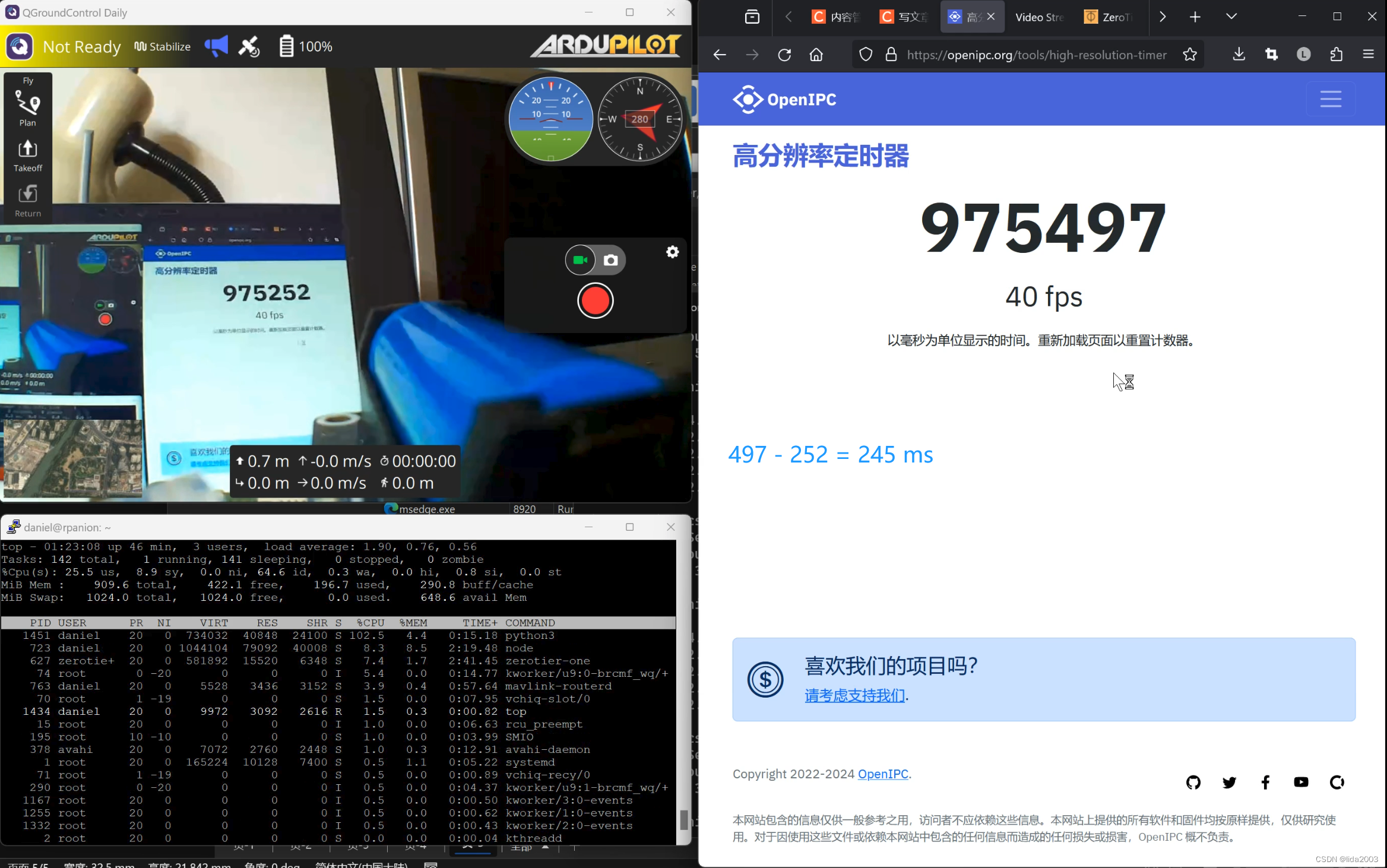
Rpanion OV5647 ZeroTier 网络拓扑B 性能实测
4.3 第三次测试
使用更加贴近实际场景,两个4G LTE独享带宽【网络拓扑C】。
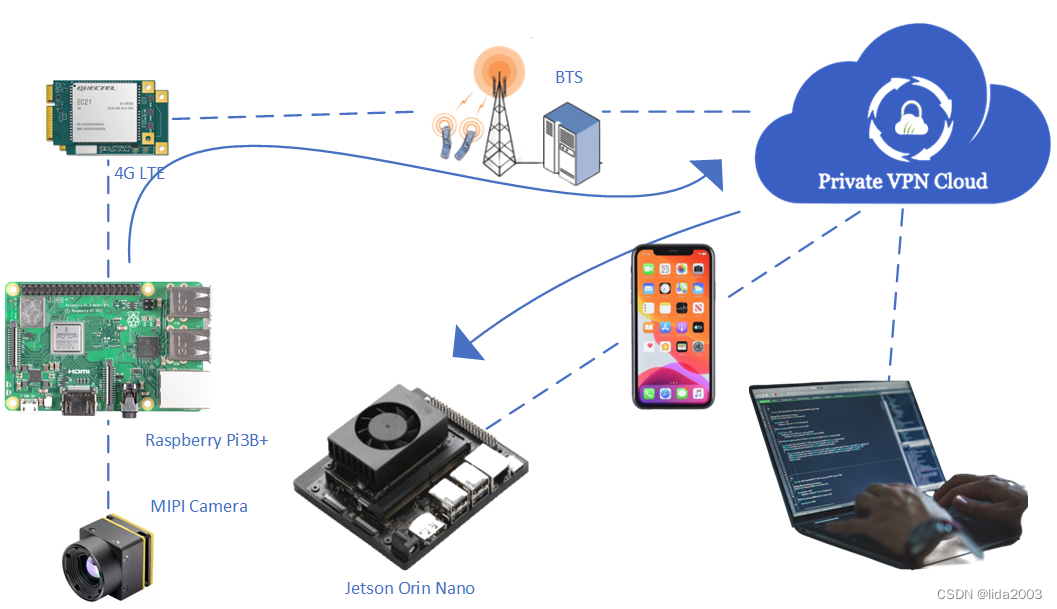
4.3.1 测试数据
$ iperf -b 3000pps -u -e -i 1 -l 1400 -c 172.24.42.46
------------------------------------------------------------
Client connecting to 172.24.42.46, UDP port 5001 with pid 860 (1 flows)
Write buffer size: 1.37 KByte
UDP buffer size: 208 KByte (default)
------------------------------------------------------------
[ 3] local 172.24.161.33%zt44xhvvrc port 36516 connected with 172.24.42.46 port 5001
[ ID] Interval Transfer Bandwidth Write/Err PPS
[ 3] 0.0000-1.0000 sec 4.01 MBytes 33.6 Mbits/sec 3002/0 3002 pps
[ 3] 1.0000-2.0000 sec 4.00 MBytes 33.6 Mbits/sec 2999/0 3000 pps
[ 3] 2.0000-3.0000 sec 4.01 MBytes 33.6 Mbits/sec 3000/0 3000 pps
[ 3] 3.0000-4.0000 sec 4.00 MBytes 33.6 Mbits/sec 2999/0 3000 pps
[ 3] 4.0000-5.0000 sec 4.01 MBytes 33.6 Mbits/sec 3001/0 3000 pps
[ 3] 5.0000-6.0000 sec 4.01 MBytes 33.6 Mbits/sec 3000/0 3000 pps
[ 3] 6.0000-7.0000 sec 4.01 MBytes 33.6 Mbits/sec 3000/0 2999 pps
[ 3] 7.0000-8.0000 sec 4.01 MBytes 33.6 Mbits/sec 3000/0 3001 pps
[ 3] 8.0000-9.0000 sec 4.01 MBytes 33.6 Mbits/sec 3000/0 3000 pps
[ 3] 9.0000-10.0000 sec 4.01 MBytes 33.6 Mbits/sec 3001/0 3001 pps
[ 3] 0.0000-10.0015 sec 40.1 MBytes 33.6 Mbits/sec 30007/0 3000 pps
[ 3] Sent 30007 datagrams
[ 3] Server Report:
[ ID] Interval Transfer Bandwidth Jitter Lost/Total Datagrams
[ 3] 0.0000-10.3614 sec 37.5 MBytes 30.4 Mbits/sec 0.469 ms 1882/30006 (6.3%)
[ 3] 0.0000-10.3614 sec 2921 datagrams received out-of-order
注:更多测试数据供参考。
$ iperf -b 3000pps -u -e -i 1 -l 1400 -c 172.24.42.46
------------------------------------------------------------
Client connecting to 172.24.42.46, UDP port 5001 with pid 1484 (1 flows)
Write buffer size: 1.37 KByte
UDP buffer size: 208 KByte (default)
------------------------------------------------------------
[ 3] local 172.24.161.33%zt44xhvvrc port 39651 connected with 172.24.42.46 port 5001
[ ID] Interval Transfer Bandwidth Write/Err PPS
[ 3] 0.0000-1.0000 sec 4.01 MBytes 33.6 Mbits/sec 3001/0 3002 pps
[ 3] 1.0000-2.0000 sec 4.01 MBytes 33.6 Mbits/sec 3000/0 3000 pps
[ 3] 2.0000-3.0000 sec 4.01 MBytes 33.6 Mbits/sec 3000/0 3000 pps
[ 3] 3.0000-4.0000 sec 4.01 MBytes 33.6 Mbits/sec 3000/0 3000 pps
[ 3] 4.0000-5.0000 sec 4.01 MBytes 33.6 Mbits/sec 3000/0 3000 pps
[ 3] 5.0000-6.0000 sec 4.01 MBytes 33.6 Mbits/sec 3000/0 3000 pps
[ 3] 6.0000-7.0000 sec 4.01 MBytes 33.6 Mbits/sec 3000/0 3000 pps
[ 3] 7.0000-8.0000 sec 4.01 MBytes 33.6 Mbits/sec 3000/0 3000 pps
[ 3] 8.0000-9.0000 sec 4.01 MBytes 33.6 Mbits/sec 3000/0 3000 pps
[ 3] 9.0000-10.0000 sec 4.01 MBytes 33.6 Mbits/sec 3000/0 3000 pps
[ 3] 0.0000-10.0005 sec 40.1 MBytes 33.6 Mbits/sec 30004/0 3000 pps
[ 3] Sent 30004 datagrams
[ 3] Server Report:
[ ID] Interval Transfer Bandwidth Jitter Lost/Total Datagrams
[ 3] 0.0000-10.1356 sec 36.8 MBytes 30.4 Mbits/sec 0.174 ms 2446/30003 (8.2%)
4.3.2 数据分析
-
测试参数:
使用了以下参数进行测试:带宽设置为3000pps、使用UDP协议、启用错误报告、设置报告间隔为1秒、每个数据包大小为1400字节,连接到IP地址为172.24.42.46的服务器。 -
客户端信息:
客户端IP地址为172.24.161.33,端口36516,连接到服务器IP地址为172.24.42.46,端口5001。 -
传输数据:
在每个1秒的时间间隔内,传输了大约4.01兆字节的数据。
带宽在每秒都维持在约33.6兆位/秒。
平均每秒发送的数据包数(PPS)为3000左右。 -
UDP错误:
未发现UDP错误。 -
服务器报告:
在10.36秒的测试期间,总共传输了37.5兆字节的数据。
平均带宽为30.4兆位/秒。
报告的抖动(jitter)为0.469毫秒。
6.3%的数据包丢失率,共丢失1882个数据包。
有2921个数据包收到时是乱序的。
综上所述,该iperf测试表明UDP连接在设定的条件下运行良好,但存在一定程度的数据包丢失和乱序。
4.3.3 网络延迟分析
通过ping命令,iperf(Linux端)和QGC(Windows端),分析网络延时:
- iperf(Linux端):平均607.5ms
64 bytes from 172.24.161.33: icmp_seq=1 ttl=64 time=668 ms
64 bytes from 172.24.161.33: icmp_seq=2 ttl=64 time=583 ms
64 bytes from 172.24.161.33: icmp_seq=4 ttl=64 time=565 ms
64 bytes from 172.24.161.33: icmp_seq=5 ttl=64 time=614 ms
- QGC(Windows端):平均822.25ms
Reply from 172.24.161.33: bytes=32 time=825ms TTL=64
Reply from 172.24.161.33: bytes=32 time=854ms TTL=64
Reply from 172.24.161.33: bytes=32 time=801ms TTL=64
Reply from 172.24.161.33: bytes=32 time=809ms TTL=64
4.3.4 视频效果
实测效果: ~ 569 ms 时延; Linux端607.5/2 = 303ms, 569 - 303 = 266 ms左右。
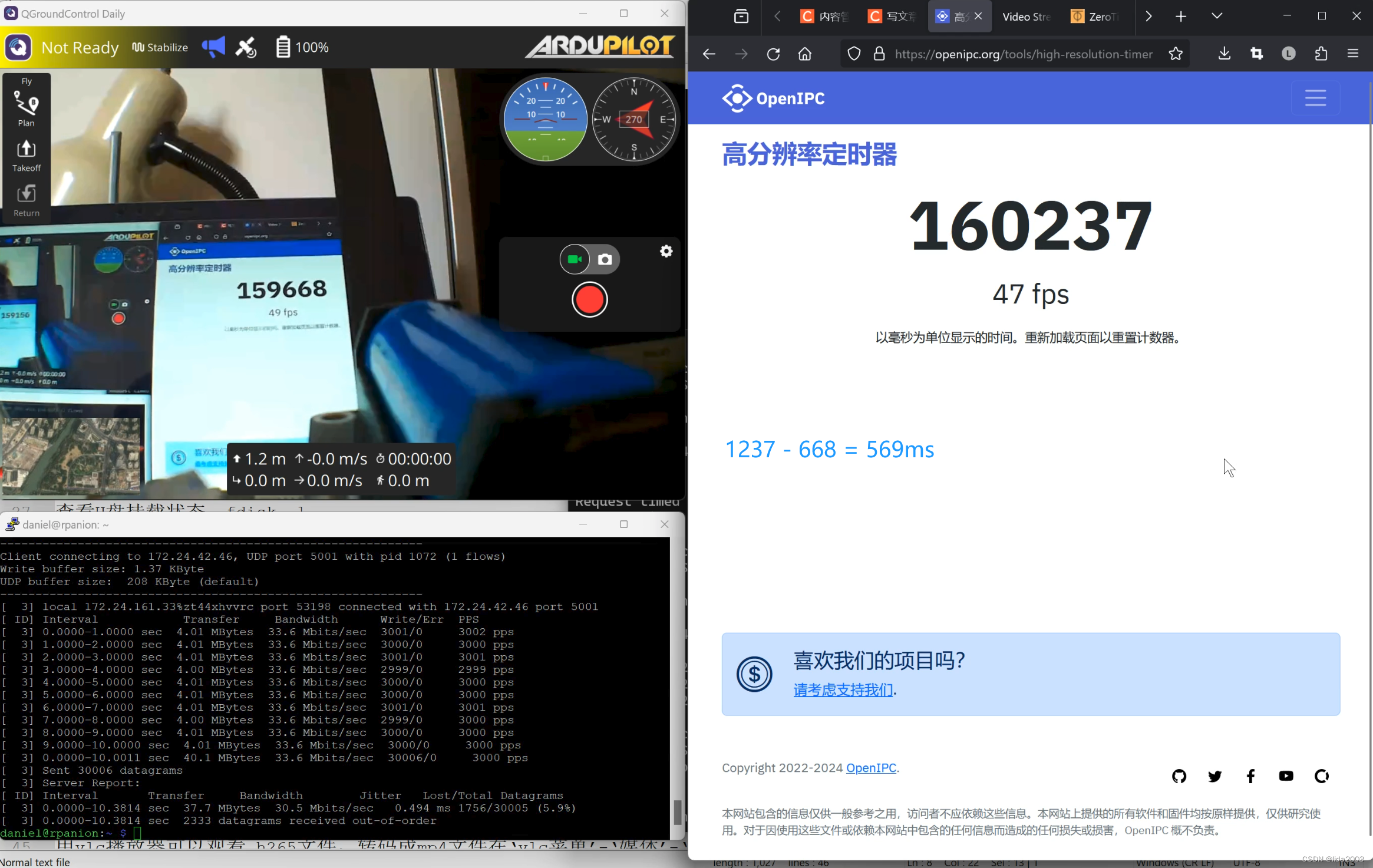
Rpanion OV5647 ZeroTier 网络拓扑C 性能实测
5. 总结
综上所述:
- 【网络拓扑A】~ 200 ms, 参考:《ArduPilot开源飞控之lida2003套机+伴机电脑首飞》
- 【网络拓扑B】~ 245 ms
- 【网络拓扑C】~ 569 ms
- 局域网点对点性能最好,直接就是Rpanion+Rpi3B+ 200ms时延。
- 统一WLAN出口,VPN仍然能够很好的优化,与局域网性能相当。
- 实际不同发射/接受链路网络,若VPN不做好优化,时延会很显著。
实际使用场景,需要看链路情况,若要进行商业部署,必须做好优化,或者自建网络(VPN/P2P等等)来控制好链路时延问题。
Ardupilot + Rpi3B+ + OV5647 + 4G LTE Copter
6. 参考资料
【1】zerotier - Securely connect any device, anywhere.
7. ZeroTier优化办法 - Moon节点
7.1 服务端配置
- Step1:安装zerotier-one
# curl -s https://install.zerotier.com/ | sudo bash
- Step2:加入自己的网络
# zerotier-cli join <Network ID>
- Step3:生成moon.json文件
# cd /var/lib/zerotier-one
# zerotier-idtool initmoon identity.public > moon.json
- Step4:修改moon.json文件 //服务器,打开安全组,开放9993端口,采用UDP协议
# vi moon.json //字段中修改:“stableEndpoints”: [“服务器的ip/9993”]
- Step5:生成签名文件 //生成一个
000000xxxxxxxxx.moon的文件
# zerotier-idtool genmoon moon.json
- Step6:新建自己的moon节点配置
# mkdir moons.d
# mv 000000xxxxxxxxx.moon moons.d
# service zerotier-one restart //之后重启服务器端B的Zerotier
7.2 客户端配置
- Step1:下载配置文件
# scp usrname@ServerIP:/var/lib/zerotier-one/moons.d/000000xxxxxxxxx.moon .
- Step2:前往zerotier安装目录 //window一般在
C:\ProgramData\ZeroTier\One - Step3:新建
ZeroTier\One\moons.d目录,并复制00000xxxx.moon - Step4:重启windows服务
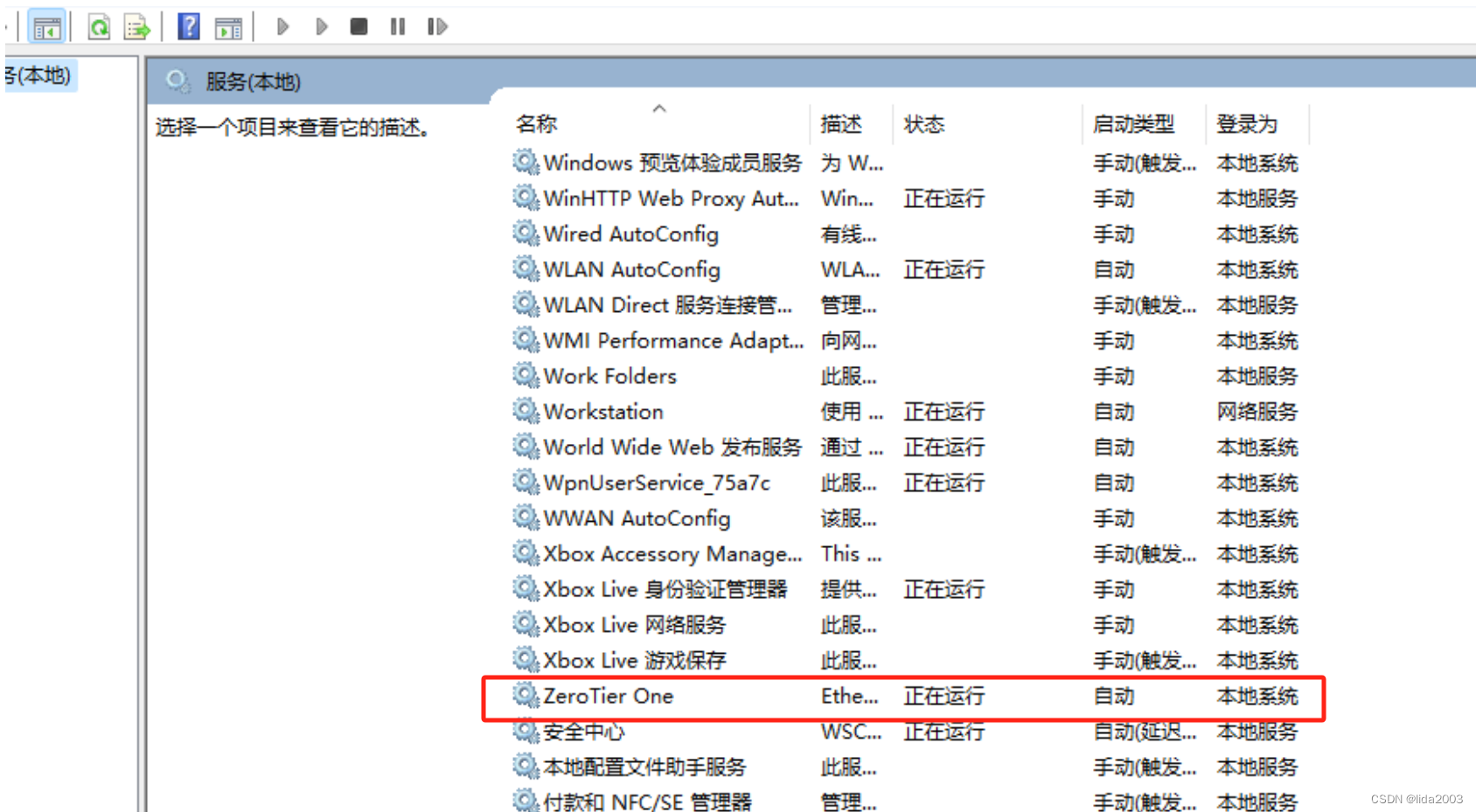 - Step5:查看moon服务器 //确认服务器(IP)和节点已经在列表中,表示成功
- Step5:查看moon服务器 //确认服务器(IP)和节点已经在列表中,表示成功
# zerotier-cli listpeers
- Step6:查看
ping延迟 //网络跳转越少,路线越短,性能越好。国内典型值在20ms左右。

8. DJI RC系统性能
DJI RC Pro features O3+ video transmission technology, capable of sending a 1080p/60fps live feed from up to 15 km away and latency as low as 120 ms.



